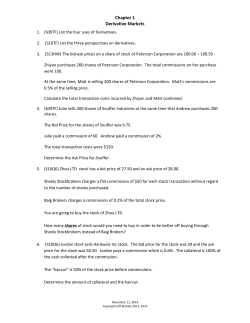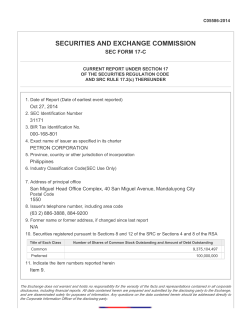
SECRET SHARING SCHEMES WITH DIVERSE IMAGE MEDIA
International Journal of Advanced Research in Computer Engineering & Technology (IJARCET)
Volume 3 Issue 11, November 2014
SECRET SHARING SCHEMES WITH
DIVERSE IMAGE MEDIA
G. Selvapriya, J. Jayapriya Jayapal
Abstract—The main aim of this project is to share an
image in a network to avoid a transmission risk
problem. Visual Secret Sharing Schemes hide a Secret
image in shares that appear noise like picture or
noiseless picture. VSS schemes suffer from a
transmission risk problem while sharing contains
Secret Images because it will awake suspicion and
increase interception risk during transmission of the
shares. To address this problem, we proposed a
natural-image-based VSS scheme (NVSS scheme) that
shares secret images via various carrier media to
protect the secret and the participants during the
transmission phase. This Process involved to Share a
Secret image over arbitrary selected natural images
(called natural shares) and one sound-like share. The
natural shares can be photos or fist-painted pictures in
digital form or in printed form. The noise-like share is
iniated based on these natural shares and the secret
image. The proposed approach gives an excellent
solution for solving the transmission risk problem for
the VSS schemes. The unaltered natural shares are
diverse and safe, thus greatly reducing the
transmission risk problem. We also propose possible
ways to conseal the noise like share to decrease the
transmission risk problem for the share.
Index Terms—Image sharing; Visual secret sharing
(VSS); Neural VSS; QR code.
I. INTRODUCTION
Visual cryptography (VC) is a technique that
encrypts a secret image into n shares, with each participant
holding one or more shares. Anyone who holds fewer than n
shares cannot reveal any information about the secret image.
Stacking the n shares reveals the secret image and it can be
recognized directly by the human visual system [1]. Secret
images can be of various types: images, handwritten
documents, photographs, and others. Sharing and delivering
secret images is also known as a visual secret sharing (VSS)
scheme. The original motivation of VC is to securely share
secret images in non-computer-aided environments;
however, devices with computational powers are ubiquitous
(e.g., smart phones). Thus, sharing visual secret images in
computer-aided environments has become an important
issue today.
G. Selvapriya, Mailam Engineering College, Mailam, Villupuram
District, Tamilnadu, India,
S. Karthik, Mailam Engineering College, Mailam, Villupuram District,
Tamilnadu, India.
Conventional shares, which consist of many random and
meaningless pixels, satisfy the security requirement for
protecting secret contents [1-4], but they suffer from two
drawbacks: first, there is a high transmission risk because
holding noise-like shares will cause attackers’ suspicion and
the shares may be intercepted. Thus, the risk to both the
participants and the shares increases, in turn increasing the
probability of transmission failure. Second, the meaningless
shares are not user friendly. As the number of shares
increases, it becomes more difficult to manage the shares,
which never provide any information for identifying the
shares.
Previous research into the Extended Visual Cryptography
Scheme (EVCS) or the user-friendly VSS scheme provided
some effective solutions to cope with the management issue
[5-13]. The shares contain many noise-like pixels or display
low-quality images. Such shares are easy to detect by the
naked eye, and participants who transmit the share can
easily lead to suspicion by others. By adopting
steganography techniques, secret images can be concealed
in cover images that are halftone gray images and true-color
images [14-16]. However, the stego-images still can be
detected by steganalysis methods [17]. Therefore the
existing VSS schemes still must be investigated for reducing
the transmission risk problem for carriers and shares. A
method for reducing the transmission risk is an important
issue in VSS schemes.
In this study, we propose a VSS scheme, called the natural
image–based VSS scheme (NVSS scheme), to reduce the
intercepted risk during the transmission phase. Conventional
VSS schemes use a unity carrier (e.g., either transparencies
or digital images) for sharing images, which limits the
practicality of VSS schemes. In the proposed scheme, we
explore the possibility of using diverse media for sharing
digital images. The carrier media in the scheme contains
digital images, printed images, hand-painted pictures, and so
on. Applying a diversity of media for sharing the secret
image increases the degree of difficulty of intercepting the
shares. The proposed NVSS scheme can share a digital
secret image over n 1 arbitrary natural images (hereafter
called natural shares) and one share. Instead of altering the
contents of the natural images, the proposed approach
extracts features from each natural share. These unaltered
natural shares are totally innocuous, thus greatly reducing
the interception probability of these shares. The generated
share that is noise-like can be concealed by using data
hiding techniques to increase the security level during the
transmission phase.
The NVSS scheme uses diverse media as a carrier;
hence it has many possible scenarios for sharing secret
3978
ISSN: 2278 – 1323
All Rights Reserved © 2014 IJARCET
International Journal of Advanced Research in Computer Engineering & Technology (IJARCET)
Volume 3 Issue 11, November 2014
images. For example, assume a dealer selects n 1 media as
natural shares for sharing a secret image.
crop the extra images. Finally, the images are resized so
they have the same dimensions as the natural shares.
B. Feature Extraction and Encryption Process
II. RELATED WORKS
A. Existing System
In an existing system, Visual cryptography Scheme
algorithm has been implemented to split the Secret image in
to n number of shares. While Sharing n no of shares through
network if any one of the share has been corrupted from
unauthorized user. The Receiver couldn’t form the
Recovered Image.
If it not corrupted from unauthorized users. After
receiving all Shares by receivers. They have to do
Superimposition of merging process to get back the
Recovered images. But the Recovered images have the
noisy share look. It wouldn’t be Clear Clarity look. These
studies had serious side effects in terms of pixel expansion
and poor display quality for the recovered images, although
the display quality of the shares was enhanced. Hence,
researchers make a tradeoff between the quality of the
shares, the quality of the recovered images, and the pixel
expansion of the images [18].
B. Proposed System
In the Proposed NVSS scheme, the natural shares can be
gray or color photographs of scenery, family activities, or
even flysheets, bookmarks, hand painted pictures, web
images, or photographs. The natural shares can be in digital
or printed form. . The encryption process only extracts
features from the natural shares; it does not alter the natural
shares. Another share, which is generated by the secret
image and features that are extracted from natural shares,
can be hidden behind other media and then delivered by a
well-disciplined person or via a high-security transmission
channel. When the number of shares n increases the
transmission risk of the conventional VSS Schemes
increases rapidly. The proposed NVSS scheme always
requires only one generated share to hide a Secret Image.
When the transmission cost is limited, the proposed scheme
using unaltered natural shares can greatly reduce
transmission risk. NVSS scheme includes two main phases
feature extraction and encryption. The feature images that
were extracted from the same natural image and the secret
image execute the XOR operation to generate one noise-like
share S. When shares are received, the decryption end
extracts feature images from all natural shares and then
executes the XOR operation with share S’ to obtain the
recovered image.
III. METHODS
The proposed system to implement the partition parallelism
we follow below methods:
A. Image Selection and Image Preparation
Initially Secret Image and Natural Images has been Chosen.
Natural Images would be Painted and Digital Images. The
image preparation processes are used for preprocessing
printed images and for post-processing the feature matrices
that are extracted from the printed images. The flow of
Image Preparation process is: The contents of the printed
images can be acquired by popular electronic devices, such
as digital scanners and digital cameras. The next step is to
This module describes the feature extraction process that
extracts feature images from the natural shares. The module
which is the core module of the feature extraction process is
applicable to printed and digital images simultaneously
Assume that the size of the natural shares and the secret
image are w * h pixels and that each natural share is divided
into a number of b *b pixel blocks before feature extraction
starts. We define the notations as follows:
b represents the block size, b belongs to even.
N denotes a natural share.
(x,y) denotes the coordinates of pixels in the
natural shares and the secret image, 1 <=x <=w, 1
<=y <=h.
(x1, y1) represents the coordinates of the left-top
pixel in each block.
Pxy denotes the value of color , {R,G,B} for
pixel (x, y) in natural share N,
0 <=p x,y<= 255.
Pixel value Hx,y is the sum of RGB color values of
pixel (x, y) in natural share N and
Hx,y= R _ px,y+ G _ px,y+ Bpx,y
M represents the median of all pixel values
(Hx1,y1, . . . ,Hxb,yb _ in a block of N.
F is the feature matrix of N, the element f x,y belongs to F
denotes the feature value of pixel (x, y) If the feature value f
x,y is 0, the feature of pixel (x, y)in N is defined as black. If f
x,y is 1 the feature of pixel (x, y)in N is defined as white.
Then the bit-plane of the secret image (resp. noise-like
share) and n - 1 feature matrices execute the XOR operation
(denoted by __ to obtain the bit-plane of the share image
(resp. recovered image). Therefore, to encrypt (resp.
decrypt) a true-color secret image, the encryption (resp.
decryption) procedure must be performed iteratively on the
24 bit-planes. The input natural shares (N1, . . . ,Nn-1) of the
scheme include np printed images and nd digital images (np
>=0, nd >=0,n= np +nd +1, and n =np + nd +1. The np
printed images must be processed and transformed into
digital form in the image preparation process. Input Secret
image S and feature images FI1……,FIn-1 by applying the
XOR operation in each color plane. Finally, the resultant
image S’ is the output.
Then the encrypted input images include n natural shares
and one secret image. The output image is a noise-like share
called Encrypted Image [19].
C. QRCODE Generation and Network Sharing Process
In this module Quick-Response Code (QR code) techniques
are introduced to conceal the noise-like share and further
3979
ISSN: 2278 – 1323
All Rights Reserved © 2014 IJARCET
International Journal of Advanced Research in Computer Engineering & Technology (IJARCET)
Volume 3 Issue 11, November 2014
reduce intercepted risk for the share during the transmission
phase. The Encrypted Image Would is converted in to
binary numbers. The Whole binary wouldn’t possible to
embed into QRCODE.Only Certain limited number of
Characters should be embed into QRCODE.For that Purpose
the whole binary numbers will be split into certain number
of separation.That splitted binary numbers would be stored
in a collection framework with a specific key. Here Key act
as to extract the splitted binary numbers from Collection
Framework. After storing all Splitted binary numbers, the
key alone has been extracted and embed in to QRCODE.
After Forming QRCODE, Network Sharing Process has
been done from sender to Receiver. The Sender has to send
Natural Shares, QRCODE and Collection Framework.
Receiver has to receive the Images, when they prove their
Ownership. If Receiver doesn’t prove their Ownership, the
images not yet received.
Fig. 1 Image sharing using NVSS.
D. Encrypted Image Extraction and Decryption process
After Receiver Receives all the Images has to scan the
QRCODE by using Smart Phone which contains QRCODE
READER Application. When the Scanning process done
Receiver got all the keys for splitted binary values. Then
Send the key values to Receiver Application By Socket
Communication. By using that Keys Receiver has to extract
the splitted binary numbers from Collection Framework then
Form the Encrypted Images. When Receiver Form the
Encrypted
ted Images Decryption Process has be done by
similar to Encryption method what Sender done [20].
Then the decrypted input images include n natural shares
and one noise-like
like share. The output image is a recovered
image.
IV. CONCLUSION
After Decryption process
ss has been done, Recovered Image
will be formed. By using comparing the pixel values of
Secret image and Recovered image we can found there is no
Pixel Expansion or Pixel corruption in the Recovered image.
her is no change between Secret image and Recovered
Recover
image.
It provides four major contributions. First, this is the first
attempt to share images via heterogeneous carriers in a VSS
scheme. Second, we successfully introduce hand-printed
hand
images for images-haring
haring schemes. Third, this study
proposes a usefull concept and method for using unaltered
images as shares in a VSS scheme. Fourth, we develop a
method to store the noise share as the QR code.
REFERENCES
[1]
1] M. Naor and A. Shamir, “Visual cryptography,” in
Advances in Cryptology,, vol. 950. New York, NY, USA:
Springer-Verlag, 1995, pp. 1–12.
[2] R. Z.Wang, Y. C. Lan, Y. K. Lee, S. Y. Huang, S. J.
Shyu, and T. L. Chia, “Incrementing visual cryptography
using random grids,” Opt. Commun.,, vol. 283, no. 21, pp.
4242–4249, Nov. 2010.
[3] P. L. Chiu and K. H.. Lee, “A simulated annealing
algorithm for general threshold visual cryptography
schemes,” IEEE Trans. Inf. Forensics Security
Security, vol. 6, no. 3,
pp. 992–1001, Sep. 2011.
[4] K. H. Lee and P. L. Chiu, “Image size invariant visual
cryptography for general access
ess structures subject to display
quality constraints,” IEEE Trans. Image Process.
Process., vol. 22,
no. 10, pp. 3830–3841, Oct. 2013.
[5] G. Ateniese, C. Blundo, A. D. Santis, and D. R. Stinson,
“Extended capabilities for visual cryptography,” Theoretical
Comput. Sci., vol. 250, nos. 1–2,
2, pp. 143
143–161, Jan. 2001.
[6] C. N. Yang and T. S. Chen, “Extended visual secret
sharing schemes:Improving the shadow image quality,” Int.
J. Pattern Recognit. Artif. Intell.,, vol. 21, no. 5, pp. 879
879–
898, Aug. 2007.
[7] K. H. Lee and
nd P. L. Chiu, “An extended visual
cryptography algorithmfor general access structures,” IEEE
Trans. Inf. Forensics Security,, vol. 7, no. 1, pp. 219
219–229,
Feb. 2012.
[8] Z. Zhou, G. R. Arce, and G. D. Crescenzo, “Halftone
visual cryptography,” IEEE Trans. Image
mage Process.
Process., vol. 15,
no. 8, pp. 2441–2453, Aug. 2006.
[9] Z. Wang, G. R. Arce, and G. D. Crescenzo, “Halftone
visual cryptography via error diffusion,” IEEE Trans. Inf.
Forensics Security,, vol. 4,no. 3, pp. 383
383–396, Sep. 2009.
[10] I. Kang, G. R. Arce, and H. K. Lee, “Color extended
visual cryptography using error diffusion,” IEEE Trans.
Image Process.,, vol. 20, no. 1, pp. 132–145,
132
Jan. 2011.
[11] F. Liu and C. Wu, “Embedded extended visual
cryptography schemes,” IEEE Trans. Inf. Forensics
Security, vol. 6, no. 2, pp. 307–322,
322, Jun. 2011.
[12] T. H. Chen and K. H. Tsao, “User
“User-friendly randomgrid-based visual secret sharing,” IEEE Trans. Circuits Syst.
Video Technol.,, vol. 21, no. 11, pp. 1693
1693–1703, Nov. 2011.
[13] T. H. N. Le, C. C. Lin, C. C. Chang, and H. B. Le, “A
high quality and small shadow size visual secret sharing
scheme based on hybrid strategy for grayscale images,”
Digit. Signal Process.,, vol. 21, no. 6, pp. 734
734–745, Dec.
2011.
[14] D. S. Tsai, G. Horng, T. H. Chen, and Y. T. Huang, “A
novel secret
cret image sharing scheme for true
true-color images
with size constraint,” Inf. Sci.,, vol. 179, no. 19, pp. 3247
3247–
3254, Sep. 2009.
[15] X. Wu, D. Ou, Q. Liang, and W. Sun, “A user
user-friendly
secret image sharing scheme with reversible steganography
based on cellular automata,” J. Syst. Softw.
Softw., vol. 85, no. 8,
pp. 1852–1863, Aug. 2012.
International Journal of Advanced Research in Computer Engineering & Technology (IJARCET)
Volume 3 Issue 11, November 2014
[16] C. Guo, C. C. Chang, and C. Qin, “A multi-threshold
secret image sharing scheme based on MSP,” Pattern
Recognit. Lett., vol. 33, no. 12, pp. 1594–1600, Sep. 2012.
[17] A. Nissar and A. H. Mir, “Classification of steganalysis
techniques: A study,” Digit. Signal Process., vol. 20, no. 6,
pp. 1758–1770, Dec. 2010.
[18] P. L. Chiu, K. H. Lee, K. W. Peng, and S. Y. Cheng,
“A new color image sharing scheme with natural shadows,”
in Proc. 10th WCICA, Beijing, China, Jul. 2012, pp. 4568–
4573.
[19] (2013). QR Code.com [Online]. Available:
http://www.qrcode.com/en/index.html (Accessed).
[20] J. Fridrich, M. Goljan, and D. Soukal, “Perturbed
quantization steganography with wet paper codes,” in Proc.
Workshop Multimedia Sec., Magdeburg, Germany, Sep.
2004, pp. 4–15.
G. Selvapriya has published two papers in national level
conference. Research interests lies in the areas of Information
Forensics and Security, Cloud Computing, Software Engineering
and Web Services.
J. Jayapriya Jayapal, M.C.A., M.Phil., M.E., M.B.A., Assistant
Professor, Mailam Engineering College.
3981
ISSN: 2278 – 1323
All Rights Reserved © 2014 IJARCET
© Copyright 2025










